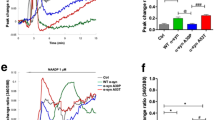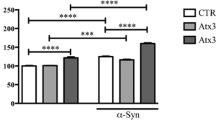Abstract
Alpha-synuclein (α-syn) is a major component of Lewy bodies found in sporadic and inherited forms of Parkinson’s disease (PD). Mutations in the gene encoding α-syn and duplications and triplications of wild-type (WT) α-syn have been associated with PD. Several mechanisms have been implicated in the degeneration of dopaminergic neurons in PD, including oxidative stress and mitochondrial dysfunction. Here we defined the occurrence of oxidative stress in SH-SY5Y cells overexpressing WT α-syn in a doxycycline (Dox) regulated manner, before and after exposure to iron (500 µM), and determined the changes in proteins involved in the intracellular antioxidant defense system. Data evidenced an increase in caspase-3 activation and diminished reducing capacity of −Dox cells, associated with decreased activity of mitochondria complex I and reduced mitochondrial transcription factor A (TFAM) levels in these cells. Furthermore, total and mitochondrial reactive oxygen species levels were higher under basal conditions in cells overexpressing α-syn (−Dox) and this increase was apparently correlated with diminished levels and activities of SOD1 and SOD2 in −Dox cells. Moreover, both reduced and oxidized glutathione levels were diminished in −Dox cells under basal conditions, concomitantly with decreased activity of GCL and reduced protein levels of GCLc. The effects caused by iron (500 µM) were mostly independent of α-syn expression and triggered different antioxidant responses to possibly counterbalance higher levels of free radicals. Overall, data suggest that overexpression of α-syn modifies the antioxidant capacity of SH-SY5Y cells due to altered activity and protein levels of SOD1 and SOD2, and decreased glutathione pool.





Similar content being viewed by others
References
Alberio T, Lopiano L, Fasano M (2012) Cellular models to investigate biochemical pathways in Parkinson’s disease. FEBS J 279(7):1146–1155. doi:10.1111/j.1742-4658.2012.08516.x
Anandhan A, Rodriguez-Rocha H, Bohovych I et al (2014) Overexpression of alpha-synuclein at non-toxic levels increases dopaminergic cell death induced by copper exposure via modulation of protein degradation pathways. Neurobiol Dis. doi:10.1016/j.nbd.2014.11.018
Armstrong JS, Whiteman M, Yang H, Jones DP, Sternberg P Jr (2004) Cysteine starvation activates the redox-dependent mitochondrial permeability transition in retinal pigment epithelial cells. Invest Ophthalmol Vis Sci 45(11):4183–4189. doi:10.1167/iovs.04-0570
Ayton S, Lei P, Duce JA et al (2013) Ceruloplasmin dysfunction and therapeutic potential for Parkinson disease. Ann Neurol 73(4):554–559. doi:10.1002/ana.23817
Baillet A, Chanteperdrix V, Trocme C, Casez P, Garrel C, Besson G (2010) The role of oxidative stress in amyotrophic lateral sclerosis and Parkinson’s disease. Neurochem Res 35(10):1530–1537. doi:10.1007/s11064-010-0212-5
Bender AS, Reichelt W, Norenberg MD (2000) Characterization of cystine uptake in cultured astrocytes. Neurochem Int 37(2–3):269–276
Bharucha KJ, Friedman JK, Vincent AS, Ross ED (2008) Lower serum ceruloplasmin levels correlate with younger age of onset in Parkinson’s disease. J Neurol 255(12):1957–1962. doi:10.1007/s00415-009-0063-7
Byers B, Cord B, Nguyen HN et al (2011) SNCA triplication Parkinson’s patient’s iPSC-derived DA neurons accumulate alpha-synuclein and are susceptible to oxidative stress. PLoS One 6(11):e26159. doi:10.1371/journal.pone.0026159
Chinta SJ, Kumar MJ, Hsu M et al (2007) Inducible alterations of glutathione levels in adult dopaminergic midbrain neurons result in nigrostriatal degeneration. J Neurosci 27(51):13997–14006. doi:10.1523/JNEUROSCI.3885-07.2007
Chu Y, Kordower JH (2007) Age-associated increases of alpha-synuclein in monkeys and humans are associated with nigrostriatal dopamine depletion: Is this the target for Parkinson’s disease? NeurobiolDis 25(1):134–149. doi:10.1016/j.nbd.2006.08.021
Chu Y, Le W, Kompoliti K, Jankovic J, Mufson EJ, Kordower JH (2006) Nurr1 in Parkinson’s disease and related disorders. J Comp Neurol 494(3):495–514. doi:10.1002/cne.20828
Dauer W, Przedborski S (2003) Parkinson’s disease: mechanisms and models. Neuron 39(6):889–909
Double KL, Reyes S, Werry EL, Halliday GM (2010) Selective cell death in neurodegeneration: Why are some neurons spared in vulnerable regions? Prog Neurobiol 92(3):316–329. doi:10.1016/j.pneurobio.2010.06.001
Dun Y, Mysona B, Van ET et al (2006) Expression of the cystine-glutamate exchanger (xc-) in retinal ganglion cells and regulation by nitric oxide and oxidative stress. Cell Tissue Res 324(2):189–202. doi:10.1007/s00441-005-0116-x
Hissin PJ, Hilf R (1976) A fluorometric method for determination of oxidized and reduced glutathione in tissues. Anal Biochem 74(1):214–226
Hybertson BM, Gao B, Bose SK, McCord JM (2011) Oxidative stress in health and disease: the therapeutic potential of Nrf2 activation. Mol Aspects Med 32(4–6):234–246. doi:10.1016/j.mam.2011.10.006
Ihara Y, Chuda M, Kuroda S, Hayabara T (1999) Hydroxyl radical and superoxide dismutase in blood of patients with Parkinson’s disease: relationship to clinical data. J Neurol Sci 170(2):90–95
Jellinger KA (2008) A critical reappraisal of current staging of Lewy-related pathology in human brain. Acta Neuropathol 116(1):1–16. doi:10.1007/s00401-008-0406-y
Jenner P (2003) Oxidative stress in Parkinson’s disease. Ann Neurol 53(Suppl 3):S26–S36. doi:10.1002/ana.10483
Jenner P, Dexter DT, Sian J, Schapira AH, Marsden CD (1992) Oxidative stress as a cause of nigral cell death in Parkinson’s disease and incidental Lewy body disease. The Royal Kings and Queens Parkinson’s Disease Research Group. Ann Neurol 32(Suppl):S82–S87
Junn E, Mouradian MM (2002) Human alpha-synuclein over-expression increases intracellular reactive oxygen species levels and susceptibility to dopamine. Neurosci Lett 320(3):146–150
Kalyanaraman B, Darley-Usmar V, Davies KJ et al (2012) Measuring reactive oxygen and nitrogen species with fluorescent probes: challenges and limitations. Free Radic Biol Med 52(1):1–6. doi:10.1016/j.freeradbiomed.2011.09.030
Kawamata H, Manfredi G (2010) Import, maturation, and function of SOD1 and its copper chaperone CCS in the mitochondrial intermembrane space. Antioxid Redox Signal 13(9):1375–1384. doi:10.1089/ars.2010.3212
Kim HJ, Jeon BS, Yoon MY, Park SS, Lee KW (2012) Increased expression of alpha-synuclein by SNCA duplication is associated with resistance to toxic stimuli. J Mol Neurosci 47(2):249–255. doi:10.1007/s12031-012-9732-6
Ko L, Mehta ND, Farrer M et al (2000) Sensitization of neuronal cells to oxidative stress with mutated human alpha-synuclein. J Neurochem 75(6):2546–2554
Krejsa CM, Franklin CC, White CC, Ledbetter JA, Schieven GL, Kavanagh TJ (2010) Rapid activation of glutamate cysteine ligase following oxidative stress. J Biol Chem 285(21):16116–16124. doi:10.1074/jbc.M110.116210
Lall MM, Ferrell J, Nagar S, Fleisher LN, McGahan MC (2008) Iron regulates l-cystine uptake and glutathione levels in lens epithelial and retinal pigment epithelial cells by its effect on cytosolic aconitase. Invest Ophthalmol Vis Sci 49(1):310–319. doi:10.1167/iovs.07-1041
Lee M, Hyun D, Halliwell B, Jenner P (2001) Effect of the overexpression of wild-type or mutant alpha-synuclein on cell susceptibility to insult. J Neurochem 76(4):998–1009
Li W, Lesuisse C, Xu Y, Troncoso JC, Price DL, Lee MK (2004) Stabilization of alpha-synuclein protein with aging and familial Parkinson’s disease-linked A53T mutation. J Neurosci 24(33):7400–7409. doi:10.1523/JNEUROSCI.1370-04.2004
Lim JL, Wilhelmus MM, de Vries HE, Drukarch B, Hoozemans JJ, van Horssen J (2014) Antioxidative defense mechanisms controlled by Nrf2: state-of-the-art and clinical perspectives in neurodegenerative diseases. Arch Toxicol 88(10):1773–1786. doi:10.1007/s00204-014-1338-z
Mari M, Morales A, Colell A, Garcia-Ruiz C, Kaplowitz N, Fernandez-Checa JC (2013) Mitochondrial glutathione: features, regulation and role in disease. Biochim Biophys Acta 1830(5):3317–3328. doi:10.1016/j.bbagen.2012.10.018
Martin HL, Teismann P (2009) Glutathione—a review on its role and significance in Parkinson’s disease. FASEB J 23(10):3263–3272. doi:10.1096/fj.08-125443
Moon HE, Paek SH (2015) Mitochondrial dysfunction in Parkinson’s disease. Exp Neurobiol 24(2):103–116. doi:10.5607/en.2015.24.2.103
Nakamura H, Nakamura K, Yodoi J (1997) Redox regulation of cellular activation. Annual review of immunology 15:351–369. doi:10.1146/annurev.immunol.15.1.351
Paglia DE, Valentine WN (1967) Studies on the quantitative and qualitative characterization of erythrocyte glutathione peroxidase. J Lab Clin Med 70(1):158–169
Pearce RK, Owen A, Daniel S, Jenner P, Marsden CD (1997) Alterations in the distribution of glutathione in the substantia nigra in Parkinson’s disease. J Neural Transm 104(6–7):661–677
Perfeito R, Cunha-Oliveira T, Rego AC (2013) Revisiting oxidative stress and mitochondrial dysfunction in the pathogenesis of Parkinson disease-resemblance to the effect of amphetamine drugs of abuse. Free Rad Biol Med 62:186–201. doi:10.1016/j.freeradbiomed.2013.05.042
Perfeito R, Lazaro DF, Outeiro TF, Rego AC (2014) Linking alpha-synuclein phosphorylation to reactive oxygen species formation and mitochondrial dysfunction in SH-SY5Y cells. Mol Cell Neurosci 62:51–59. doi:10.1016/j.mcn.2014.08.002
Perry TL, Godin DV, Hansen S (1982) Parkinson’s disease: a disorder due to nigral glutathione deficiency? Neurosci Lett 33(3):305–310
Riederer P, Sofic E, Rausch WD et al (1989) Transition metals, ferritin, glutathione, and ascorbic acid in parkinsonian brains. J Neurochem 52(2):515–520
Robinson KM, Janes MS, Beckman JS (2008) The selective detection of mitochondrial superoxide by live cell imaging. Nat Protoc 3(6):941–947. doi:10.1038/nprot.2008.56
Ruszkiewicz J, Albrecht J (2015) Changes in the mitochondrial antioxidant systems in neurodegenerative diseases and acute brain disorders. Neurochem Int. doi:10.1016/j.neuint.2014.12.012
Seymen O, Seven A, Candan G, Yigit G, Hatemi S, Hatemi H (1997) The effect of iron supplementation on GSH levels, GSH-Px, and SOD activities of erythrocytes in l-thyroxine administration. Acta Med Okayama 51(3):129–133
Sian J, Dexter DT, Lees AJ et al (1994) Alterations in glutathione levels in Parkinson’s disease and other neurodegenerative disorders affecting basal ganglia. Ann Neurol 36(3):348–355. doi:10.1002/ana.410360305
Sofic E, Lange KW, Jellinger K, Riederer P (1992) Reduced and oxidized glutathione in the substantia nigra of patients with Parkinson’s disease. Neurosci Lett 142(2):128–130
Sofic E, Sapcanin A, Tahirovic I et al (2006) Antioxidant capacity in postmortem brain tissues of Parkinson’s and Alzheimer’s diseases. J Neural Transm Suppl 71:39–43
Tabrizi SJ, Orth M, Wilkinson JM et al (2000) Expression of mutant alpha-synuclein causes increased susceptibility to dopamine toxicity. Hum Mol Genet 9(18):2683–2689
Thomas B, Beal MF (2007) Parkinson’s disease. Hum Mol Genet 16(Spec No. 2):R183–R194. doi:10.1093/hmg/ddm159
Torsdottir G, Kristinsson J, Sveinbjornsdottir S, Snaedal J, Johannesson T (1999) Copper, ceruloplasmin, superoxide dismutase and iron parameters in Parkinson’s disease. Pharmacol Toxicol 85(5):239–243
Vekrellis K, Xilouri M, Emmanouilidou E, Stefanis L (2009) Inducible over-expression of wild type alpha-synuclein in human neuronal cells leads to caspase-dependent non-apoptotic death. J Neurochem 109(5):1348–1362. doi:10.1111/j.1471-4159.2009.06054.x
Vekrellis K, Xilouri M, Emmanouilidou E, Rideout HJ, Stefanis L (2011) Pathological roles of alpha-synuclein in neurological disorders. Lancet Neurol 10(11):1015–1025. doi:10.1016/S1474-4422(11)70213-7
White CC, Viernes H, Krejsa CM, Botta D, Kavanagh TJ (2003) Fluorescence-based microtiter plate assay for glutamate-cysteine ligase activity. Anal Biochem 318(2):175–180
Zeevalk GD, Razmpour R, Bernard LP (2008) Glutathione and Parkinson’s disease: is this the elephant in the room? Biomed Pharmacother 62(4):236–249. doi:10.1016/j.biopha.2008.01.017
Zhou W, Hurlbert MS, Schaack J, Prasad KN, Freed CR (2000) Overexpression of human alpha-synuclein causes dopamine neuron death in rat primary culture and immortalized mesencephalon-derived cells. Brain Res 866(1–2):33–43
Zhu H, Cao Z, Zhang L, Trush MA, Li Y (2007) Glutathione and glutathione-linked enzymes in normal human aortic smooth muscle cells: chemical inducibility and protection against reactive oxygen and nitrogen species-induced injury. Mol Cell Biochem 301(1–2):47–59. doi:10.1007/s11010-006-9396-z
Zielonka J, Kalyanaraman B (2010) Hydroethidine- and MitoSOX-derived red fluorescence is not a reliable indicator of intracellular superoxide formation: another inconvenient truth. Free Radic Biol Med 48(8):983–1001. doi:10.1016/j.freeradbiomed.2010.01.028
Acknowledgments
This work was supported by FEDER funds through the Operational Programme Competitiveness Factors—COMPETE and national funds by FCT—Foundation for Science and Technology under the Project PTDC/SAU-NEU/101928/2008 and Strategic Projects UID/NEU/04539/2013 and PEst-C/SAU/LA0001/2013-2014. We also would like to thank Dr. Mário Laço from CNC for help in measuring complex I activity.
Author information
Authors and Affiliations
Corresponding author
Electronic supplementary material
Below is the link to the electronic supplementary material.
Rights and permissions
About this article
Cite this article
Perfeito, R., Ribeiro, M. & Rego, A.C. Alpha-synuclein-induced oxidative stress correlates with altered superoxide dismutase and glutathione synthesis in human neuroblastoma SH-SY5Y cells. Arch Toxicol 91, 1245–1259 (2017). https://doi.org/10.1007/s00204-016-1788-6
Received:
Accepted:
Published:
Issue Date:
DOI: https://doi.org/10.1007/s00204-016-1788-6




